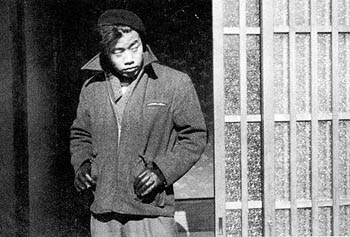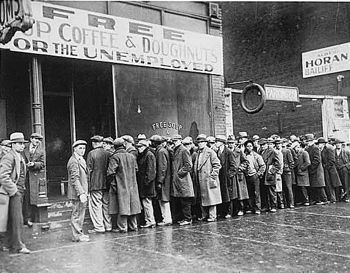The situation in the kashihon world was different. As work teams and studios began to form at the end of the '50s, the movies emerged as a model of sorts, but not because its artists dreamed of animation production. The Gekiga Studio was a crucible for this. That short-lived organization deserves an essay of its own, so I will just make a couple of points here. One of its principal aspirations had been to make manga on par with the movies, television, and other mass entertainment media. The use of “cinematic techniques” in storytelling was one thing, but oftentimes in circa 1960 kashihon gekiga one finds actors from popular Nikkatsu films appearing anonymously but unmistakably on covers and as well as in the stories themselves. On the endpapers and in the editorial afterwords, there are frequently photographs of the artists dressed like their characters, as gangsters sporting guns or boxers ready to punch. This performativity would continue after the Gekiga Studio dissolved in April 1960, sometimes in the same fashion, but also in a different way, by crediting artists as actors or directors and listing studio assistants as production crew. Such things, like the likening of divided labor in comics to that in the movie industry that one finds frequently in articles and roundtables from the late '60s, were less expressions of real similarity between the two fields than of a rampant cinephilia amongst Japanese comics authors dating back at least to Tezuka in the early '50s.

Saitō Takao was no less a movie fanatic than his peers. Later in life, he bragged about seeing up to seven movies in a single day as a teenager in the early '50s. He nicknamed himself Gorilla after one of his favorite movies, King Kong. In middle school, he painted movie signboards for extra spending money, and good friend Ishinomori recalls him talking about never-to-be-realized movie scripts and storyboards. There is some dressing up as a goon in his late '50s comics and clear nods to Nikkatsu in the early '60s. This obsession with cinema only grew with the creation of Saitō Pro in April 1960.

Dissatisfied with the profit-sharing set-up in the Gekiga Studio – a collective not a production studio – Saitō began to corral colleagues into his own operation toward the end of 1959. A few months later, right after the Gekiga Studio disbanded, this became officially Saitō Pro. In the beginning, it was a small operation of five artists and a manager, Saitō’s elder brother, who had a bachelor’s in management and experience working for a car manufacturer. In 1961, Saitō Pro began self-publication. Other ex-Gekiga Studio members followed suit, notably Satō Masaaki in May 1962 and Tatsumi Yoshihiro in 1963. Manga critic Natsume Fusanosuke has argued that this move on the part of kashihon authors in the early '60s was in large part a defensive measure to maintain profit despite a failing kashihon market. Indeed, both Satō Pro and Tatsumi’s Dai’ichi Pro seemed to have been set up primarily as self-publishing ventures specifically for the purpose to generate work for themselves, cut out the middleman, and maximize profit as kashihon publishers and commissions began to disappear. In 1996, Satō likened his decision to go into self-publishing to that of “a cockroach that senses the coming of an earthquake and looks for an escape plan for survival.” This paradigm of the late kashihon manga studio, however, does not seem to apply to Saitō. He was already moving toward formal studio production in 1959, before the end was on the horizon.

It is hard to reconstruct Saitō’s initial motivations for creating Saitō Pro, primarily because there are no published statements by him on studio production before 1967, which is to say, until after Saitō Pro had matured into a stable, integrated operation. The conventional explanation is that he was inspired by movie-making, but I think the parentage of Saitō Pro is more complex. As his defection from the Gekiga Studio attests, he was one of the most in-demand kashihon authors, and one imagines the plain reality of too much work for him to do himself. Further, Saitō was a professed fan of American comics. Osabe mentions that the model of “ten cent comics” has played a part in shaping Saitō’s ideas about the kind of entertainment he wants to make (something for kids and adults alike). But he does not say that they had anything to do with how Saitō was going to make them. By the late '60s, the Marvel Method was widely known in the Japanese comics industry, but I have not found concrete evidence that Saitō had any knowledge of American studio methods at the time of Saitō Pro’s founding. Statements from the late '60s inevitably emphasize similarities to film production, but the specific language Saitō uses suggests other influences. For example, in 1969, popular literature critic Ozaki Hotsuki quotes the artist as follows: “I think the individual talents of assistants can be best utilized if gekiga continues to develop the system of divided labor. When manga production centers upon a single gekiga author at its core, with the staff exercising its skills to the maximum, and the product expresses itself a single integrated art [sōgō geijutsu], it is then that manga is most entertaining.” This seems to me more the language of the corporate world and the assembly line, not movie-making. One wonders how much Saitō Pro and Saitō’s thinking was shaped by his brother’s business degree and experience in the automobile industry. It was, after all, precisely because of that background that Saitō asked him to manage the studio.

As circumstantial evidence of an industrial context for Saitō Pro, consider the following. Saitō’s most popular kashihon title was Typhoon Gorō (1958-62). At its height circa 1960, this serial about a dashing young fast-draw detective had a print-run of 5000-6000, second in the kashihon market only to Shirato Sanpei’s The Legend of Kagemaru (1959-62), between 7000 and 8000. Saitō Pro was founded in the middle of its serialization. When this began I am not sure, but at some point the drawing of Gorō was aided by mechanical reproduction. His head was standardized into four aspects – front, side, left ¾, and right ¾ – each of which came in five different sizes. These variations were printed in advance and then pasted into the story accordingly. Saitō drew in the mouth and eyes afterwards in the appropriate expression. The same method was used by Akatsuka Fujio in Little Osomatsu, serialized in Shōnen Sunday beginning in 1962. In that case, replication is the central conceit of the story, as Osomatsu is one of six identical twins who raise hell with their confusing uniformity. For Saitō, the method was purely economical. It certainly saved some time, but one assumes its primary purpose was to guarantee stylistic homogeneity across different hands. Unfortunately, I was not able to find a convincing example from Typhoon Gorō to show here. As far as I know, this cut-and-paste technique was not used thereafter.






